Montana follows heart back home
Junior kicker having breakout season after transferring from the University of Memphis
Bengals’ kicker Marc Montana is a former Division 1 walk on, now he’s on pace to break school records at Buffalo State.
October 22, 2014
It was January, 2013, when Marc Montana’s eyes finally opened in a University of Memphis trainer’s room. He awoke to an IV embedded in his right arm, unsure of where he was or what had just happened.
An athletic trainer started asking questions.
Montana had questions for himself.
“I was frustrated with myself,” Montana said. “I just thought, ‘Why is this happening to me now? Will I ever play football again?’”
It was a chilly, gloomy evening and Montana and his Memphis teammates finished up a lift in the weight room and began doing conditioning drills on the practice field. Montana knew after the first stage of the eight-stage workout that something wasn’t right.
He was doing normal drills — running over pads, changing direction, pivoting. Except, Montana wasn’t feeling normal. He couldn’t seem to catch his breath. After the second stage, his ears began to pop. His legs were sore and he was breathing heavier as time went on.
He started drinking water. It got worse. Montana was waiting in line for the third stage and lost all hearing. Dizziness followed and he walked out of line to talk to the athletic trainer.
“I said, ‘I’m breathing really heavy. I’m dizzy. I can’t hear. Something is wrong,’” Montana recalled.
Before the trainer could answer, the lights went out. Montana passed out and fell to the turf beneath him.
AN UNLIKELY DESTINATION
Fast forward nearly two years. Montana walks onto Coyer Field, miles away from Memphis, sizing up what would stand as the game-tying field goal from 49 yards out.
Buffalo State mounted an unlikely comeback to get to this point —getting a fourth down stop with just one second left — and now the fate of the Bengals’ season opener rests upon the leg of a former Division I recruit.
Buffalo State head coach Jerry Boyes was breathing surprisingly easy.
Montana’s kick sailed through the uprights and so did his game-winning, 34-yarder in overtime to complete the Bengals’ unlikely 51-48 win to stun Cortland. His three field goals in the game tied a school record. It was the longest kick in the country for a month.
Six games into the season, Montana leads the Empire 8 in field goals (7) and is second in extra points (28). Both put him on pace to set school records. He needs just two field goals to tie Dan Dallas (1984) for the most made field goals in a single season.
“Marc is a very stabilizing force, when it comes to our kicking game,” Boyes said. “Once we get inside, particularly, the 30- or 35-yard line, frankly we’re in scoring position. Look at Ithaca last week, when he kicked a field goal.
In the past we’d think, ‘Jeez, a little bit of a distance here.’ With Marc, we just go in and get our three points. We don’t even think twice about it.”
— Jerry Boyes
Montana’s talent is apparent. It’s not every day a Division III football program stumbles across a leg that can nail kicks from 40 yards out with any regularity. His road to Buffalo State was anything but regular.
TROUBLE IN MEMPHIS
In the days after passing out on the field, doctors were unable to diagnosis Montana with anything in particular regarding his heart.
They assume that he must have suffered a virus prior to arriving at Memphis that may have weakened his heart. His ejection fraction time, the measure of the amount of blood leaving the heart after each contraction, was hovering around 30 percent.
For an average person, it’s 70 percent, according to Montana.
“They weren’t sure what was wrong with it,” Montana said. “They ruled out all of the options.”
After a while, Montana wasn’t struggling too much to catch his breath anymore. But he couldn’t catch a break.
Three weeks after passing out and being cleared to resume football activities, he tore his quad.
And not just a small tear.
The tear went down the whole vertical length of his quad on his kicking leg. He tried to kick through the pain. He tried to shrug it off. He did all he could to hold onto the little opportunity he still had. The opportunity to play in front of 61,000 on the big stage; the opportunity to earn a scholarship and get a free education.
Until, finally, he couldn’t take it anymore.
“It made everything worse,” he said. “It wasn’t getting better. Coach kept asking me, ‘How’s it feeling? How’s it feeling?’ When I told him I had to get a procedure done and I was going to be out for awhile, it hit everyone hard. That’s when I thought my career might be over.”
When I told him I had to get a procedure done and I was going to be out for awhile, it hit everyone hard. That’s when I thought my career might be over.
— Marc Montana
ENOUGH IS ENOUGH
Montana’s career wasn’t over. However, his time at Memphis was just about up.
It was July when he finally returned to kicking, after getting platelet injections and waiting for his quad to heal.
“It was a business so they (coaches) didn’t say, ‘This is what’s going to happen,’” Montana said.
And a business it was indeed.
Memphis recruited one of the top high school kickers in country, Jake Elliott, and gave him a full scholarship.
Elliot, a high school All-American, was as good as advertised and won the job as the team’s starting kicker as a true freshman. Elliot was even a semifinalist for the Lou Groza Award, given to the most outstanding kicker in the country.
“After the season ended and we were on Christmas break, I came back home,” Montana said. “I talked it over with my wife (Viktorija), and my family, and we decided that Memphis has a great kicker there now. [Jake] did a great job, so there really wasn’t an opportunity for me there anymore.”
“We had to figure out where I could go and where there would be an opportunity. I figured, why not come home and get familiar ground again, be with people I know and have that support.”
NEW CHANCE TO PLAY
Home, for Montana, is Clarence, New York.
One day, the phone rang in Boyes’ office. It was the first step in Montana deciding on transferring to Buffalo State and becoming the team’s starting place kicker.
Now, Montana is an important part of the Bengals’ 5-1 start, their best start since 1999. His numbers at this point of the season are some of the best in the Empire 8 and even the country.
“Generally when those things happen, I immediately give that to position coaches,” Boyes said. “Coach [Neil] Herman, our special teams coach, did a really good job following up with Marc. A lot of credit goes to Coach Herman for Marc being here.”
“In any athletic recruiting, you have to be good, but you have to be lucky, too. We’re fortunate that the turn of events through his travels, you might say, led Marc back home.”
Out of high school, Boyes and Herman didn’t try to recruit Montana, who graduated from St. Joe’s, who was attracting interest from Division I and Division II programs.
“He was touted a little bit higher than Buffalo State coming out of high school,” Boyes said. “We were out of the box there. Generally when an athlete is talented enough to play at the high levels and can get some scholarship money, generally we’re going to lose that person.”
The 2011 St. Joes graduate was a first-team All-WNY and second-team All-State honoree as a senior. He holds the Monsignor Martin Athletic Association record for the longest made field goal with the 56-yarder he hit as a junior.
From St. Joe’s, Marc was given both a football scholarship and singing scholarship to attend C.W Post, a Division II school on Long Island. His major at the time was vocal performance. He soon found out that football and singing didn’t mix. He didn’t have time to pursue both.
After spending a year as C.W Post’s starting kicker, Montana left and went to Erie Community College to focus on academics for a year.
Montana started receiving interest from some of the top Division 1 schools in country. Ole Miss was interested, which is ranked No. 3 in the country now. Nebraska, Kansas, Pittsburgh, Hawaii, Old Dominion, Houston and East Carolina came calling, too.
Montana wound up picking Memphis.
But Boyes got lucky.
The Bengals already had senior kickers Nate Benoit and Alex Debbins on the team. Benoit was a two-year starter and Debbins was the starting kicker in 2013.
But Boyes took advantage of an opportunity to welcome a kicker with Division I talent to a Division III program, which entered this season with high expectations.
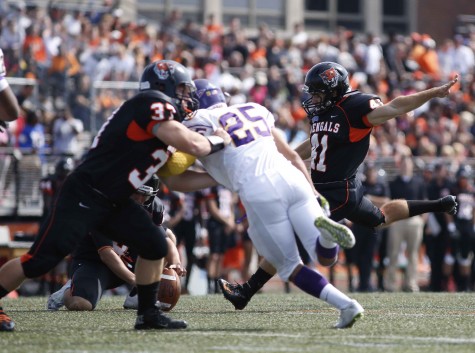
Junior kicker Marc Montana needs just three field goals to a break a 30-year old school for field goals in a single season.
A LEG UP ON OPPONENTS
And boy, has it worked out well.
Montana made waves nationally with the 49-yard, game-tying kick against Cortland.
“That kick meant everything,” Boyes said. “It meant everything to Marc and to this team. There was an immediate rally from the rest of the team. We saw that skill set in the preseason and the potential of making a kick of that distance.”
He is the only kicker in the Empire 8 to hit a field goal longer than 40 yards, and one of only six players in country to make a kick of 49 yards or more.
“That game just told everybody, ‘Hey we can always count on this guy,” Herman said. “We kind of suspected that because of some of the things he did during training camp and practice. If there was any doubt, that solidified it.”
Montana impacts more than just field goals.
Herman added that having Montana changes everything for the team offensively. Buffalo State is second in the Empire 8 in scoring, averaging 38 points per game. It allows Boyes and the offense to look at the game differently.
“You can actually call your game a little differently,” Herman said. “We know that we got three points already, or at least an attempt at three points. If we’re doing a two-minute drill, we don’t have to get to the 10 or 15-yard line. We just need to get to the 30 or 35 and we’ll at least have a chance.”
Montana’s arrival has made a huge impact in Buffalo State’s kickoff coverage. He leads the Empire 8 with nine touchbacks. The Bengals are limiting opponents to a conference-best 18.9 yards-per-return. Give Montana a strong wind, and he can drill it through the end zone.
“That’s something that is totally, totally undervalued,” Herman said. “It’s so difficult to cover kicks. The placement is so important. When Marc hits his best kick, he hits it to the five-yard line or goal line, right outside of the numbers. Sometimes that’s even better than a touchback.”
“Returners are often fielding those balls either running sideways or running backwards. Kickoffs are all about timing. When the returner is running sideways or backwards, he’s already done.”
YEARS LATER, NO DIAGNOSIS
Opportunity was all Montana wanted at Memphis. His bumps in the road hindered his opportunity.
Doctors still have not been able to put their finger on what went wrong that day.
For the next several months after passing out on the field, Montana was on Alpha-Beta Blockers to keep his blood vessels open and relaxed. He carried around an EKG for the next few months, in an attempt for doctors to figure actually what was wrong. The EKG sent readings of his heart to doctors whenever he felt pain or discomfort.
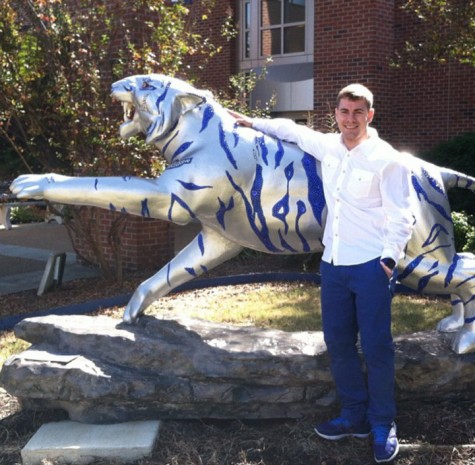
Montana is pictured with a Tiger statue at the University of Memphis.
He then went through an EP test, electrically shocking the heart to see if it would skip beats.
Montana would routinely deal with chest pain and shortness of breath.
“It took a long time for the heart to recover,” Montana said. “To this day, my ejection fraction time is only around 55 and it’s not going to get better. I’ve just had to adapt.”
ADDING FOCUS TO HEALTH
His heart isn’t as strong as the rest of his teammates, and despite Montana’s position, he had to make adjusts to his routine. His quad injury also made it evident that he had to treat his body a different way.
“I have to be proactive to staying healthy,” Montana said. “I have to make sure my body is loose and not in the place where it was when I got hurt. I’m mostly just keeping up with conditioning. Whatever the coaches ask me to do, I try to do the best that I can.
“I’m always emphasizing on hydration. That’s probably one of the problems I went into at Memphis, a lack of hydration.”
Montana was training in Buffalo prior to spring practice, but once practice started at Memphis, it went to a whole new level.
“They buried us,” Montana said grinning, “and they said it’s suppose to bury you, though. I wasn’t the only one who dropped out, but I was the only one that passed out…Since that happened, they actually made a rule that they wouldn’t do that to the incoming players anymore.”
NO REGRETS
Finally, Montana has stable ground to plant on. It’s been a difficult few years for him, at times. He’s dealt with injuries. He’s recovered from an undiagnosed heart problem. He’s matured.
A lot has changed since he graduated St. Joe’s. He’s married and has a five-month-old daughter, Stella.
Back to those questions he once had at Memphis. Does he still think about? Why did his episode happen when it did? What if he never had had it? What if he never would have torn his quad? What if he could have take full advantage of his opportunity?
What if he was kicking at Memphis? What if …
Montana interrupts.
“No, not really,” Montana said. “I’m a big person on not having regrets. A lot of people come up to me and ask me ‘would you rather be at Memphis?’ And I say, ‘no.’ I’m really happy where I am. I want to help the team that I’m on and pursue my own career. This is where I want to be.”
Email: [email protected]
Twitter: @ByDaveDeLuca


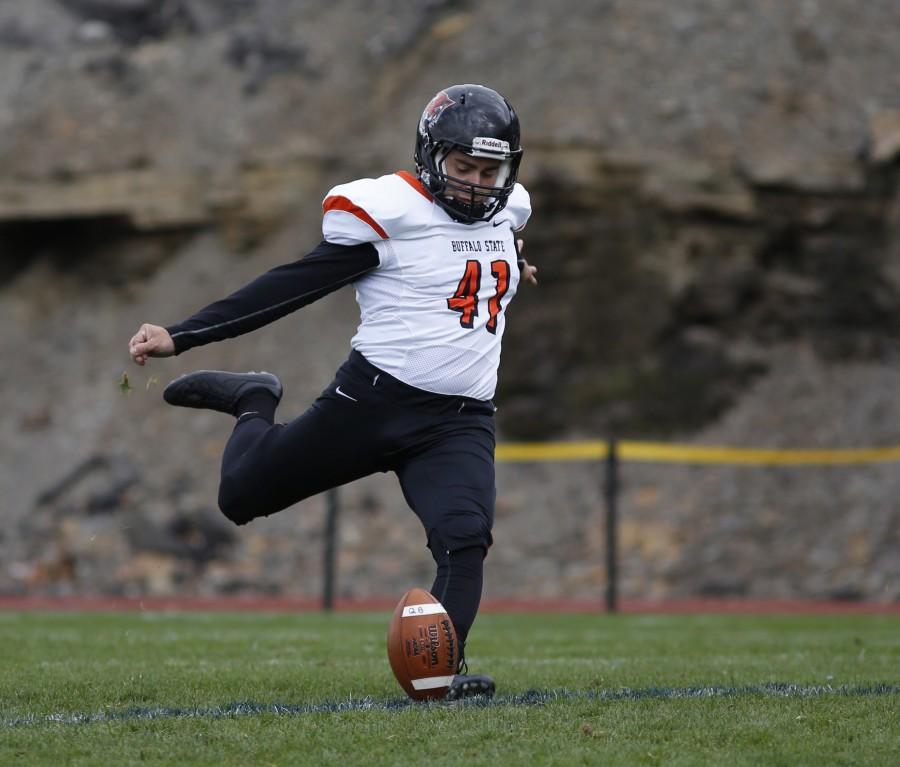







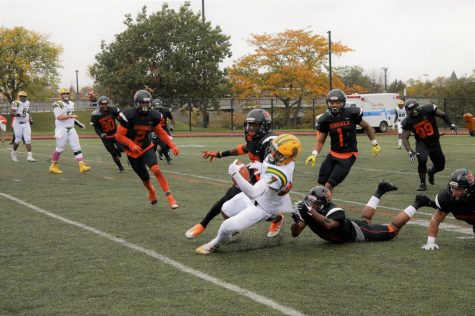
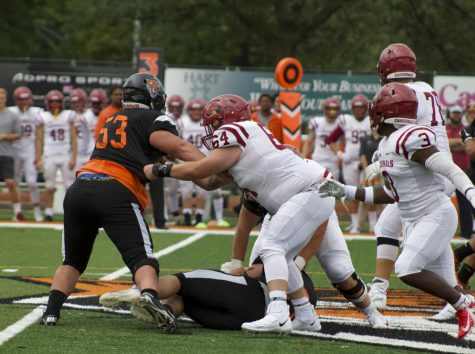
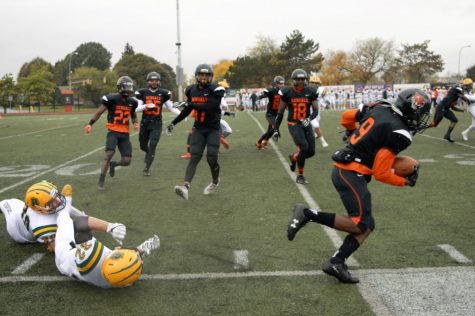
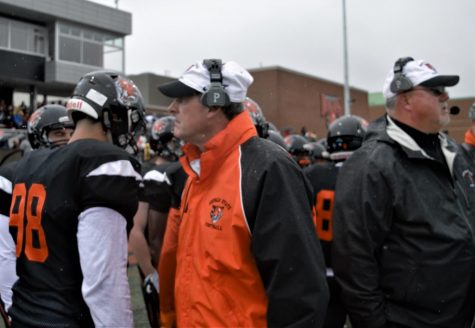
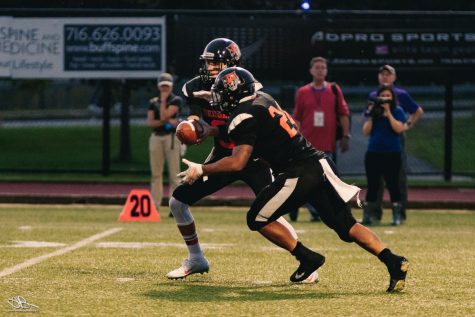
Kenneth Holmes • Oct 23, 2014 at 8:18 am
What an inspiring story. It is clear that Marc has an affinity for Tigers! I am glad he ultimately chose the Bengal Tiger at Buffalo State.